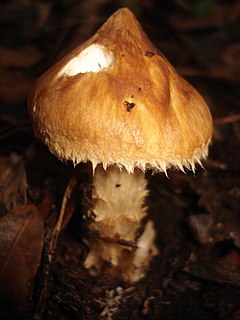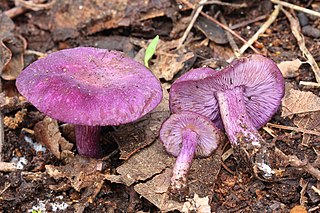Rolf Singer was a German-born mycologist and one of the most important taxonomists of gilled mushrooms (agarics) in the 20th century.

Leucopholiota is a genus of fungi in the Tricholomataceae family of mushrooms. It consists of the species Leucopholiota decorosa and Leucopholiota lignicola.
Dennisiomyces is a genus of fungi in the family Tricholomataceae. Described by mycologist Rolf Singer in 1955, the genus contains five species found in South America.
Melanomphalia is a genus of fungi in the Tricholomataceae family. The genus is monotypic, containing the single species Melanomphalia nigrescens, found in Europe. The species was first described by M.P. Christensen in 1936.
Omphaliaster is a genus of fungi in the Tricholomataceae family. The widespread genus contains seven species, predominantly in northern temperate regions.

Squamanita is a parasitic genus of agaric fungi formerly classified in the family Tricholomataceae and is now in the Cystodermateae in the Squamanitaceae. The fruitbodies of this genus resemble a normal agaric but they emerge from parasitized fruitbodies of other agarics that Squamanita has deformed. The deformation may be massive and the host may then resemble a lump, or the deformation may be so subtle that the Squamanita appears to be grafted onto the stipe of the host that nearly always fails to form a pileus. Because of the seamless graft-like attachment or the severe deformation of the host into a nonrecognizable blob, early descriptions included features of the host in descriptions of Squamanita as if they were parts of the parasite. This error led to the creation of a separate subgenus because of misinterpretation of host veil tissue as part of the parasite and ultimately a separate genus, Dissoderma. Serendipitous discovery of one parasitized host fruitbody (Galerina) that formed its own pileus that then bore three Squamanita contortipes fruitbodies revealed the parasitic nature of the relationship for that species and the entire genus. This discovery was so shocking that it was featured in Nature magazine under the title 'Mycological mystery tour'. Once the parasitic nature was revealed, the term 'protocarpic tuber' used by earlier authors for the parasitized host base was replaced by the term 'cecidiocarp' or 'cecidiocarpo' in Spanish.
Tricholosporum goniospermum is a species of fungus in the Tricholomataceae family, and the type species of the genus Tricholosporum. First described scientifically by Giacomo Bresadola in 1881 as Tricholoma goniospermum, it was transferred to the genus Tricholosporum, established in 1975 by Mexican mycologist Gaston Guzman. As was pointed out in a 1982 publication by Tim Baroni, the transfer was not valid, "because complete reference to the authors and the original publications of the basionyms was not provided". Baroni made the new combination official in his publication.
Tricholosporum atroviolaceum is a species of fungus in the Tricholomataceae family.
Tricholosporum cossonianum is a species of fungus in the Tricholomataceae family.
Tricholosporum laeteviolaceum is a species of fungus in the Tricholomataceae family. Found in South Africa, it was described as new to science in 1998.
Tricholosporum longicystidiosum is a species of fungus in the Tricholomataceae family. Found in Mexico, it was described as new to science in 1990.

Tricholosporum porphyrophyllum is a species of fungus in the Tricholomataceae family. It is found in Asia.
Tricholosporum pseudosordidum is a species of fungus in the Tricholomataceae family. It is known from Florida.
Tricholosporum subgoniospermum is a species of fungus in the Tricholomataceae family. Known from Hungary, the species was described as new to science in 1999.
Tricholosporum subporphyrophyllum is a species of fungus in the Tricholomataceae family. Found in Mexico, the species was described as new to science in 1975 by Mexican mycologist Gaston Guzman.

Tricholosporum tropicale is a species of fungus in the family Tricholomataceae. It is found in Mexico.
Tricholosporum violaceum is a species of fungus in the family Tricholomataceae. Found in Costa Rica, the species was described as new to science in 1996.






